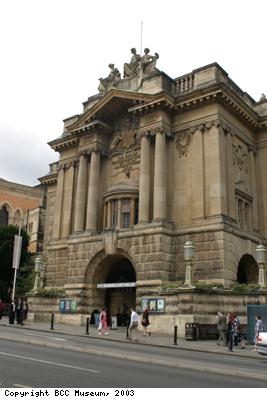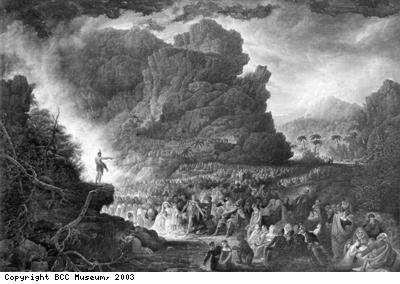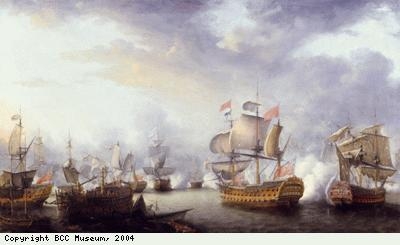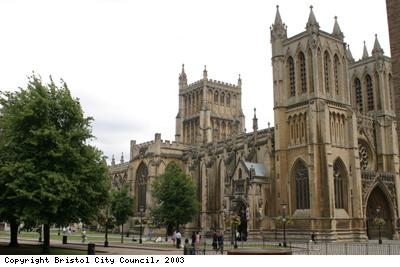Page 264 of 352 pages « First < 262 263 264 265 266 > Last »
The City Museum and Art Gallery

Description:
Photograph of Bristol Museum and Art Gallery, Queen’s Road, Bristol. The Museum was given as a gift by Sir William Henry Wills Bart to the citizens of Bristol in 1904. The Wills family made their fortune in the tobaccoo trade.In the Museum’s collections are a number of artefacts from the time of the slave trade. These are shown from time to time in special exhibitions. Many of these items will go on permanent display in the Museum of Bristol planned for the Industrial Museum site.
Creator: David Emeney
Date: 2003
Copyright: Copyright BCC Museum
St John Preaching in the Wilderness

Description:
Oil painting, St John Preaching in the Wilderness by Samuel Colman. 1822. In the foreground at the centre of this painting is the figure of a black man kneeling with his hands clasped, he is looking up at St. John. It is likely that this figure represents the image of a kneeling black slave used by anti-slavery campaigners as their logo. The kneeling slave is asking for help from his white brothers. This image was widely used to raise support and awareness for the campaign, it appears on many items, from pamphlets through to china plates. The enslaved Africans were not as passive in their role as this symbol suggests, their continual fight against slavery was the main contributing factor to its abolition. The artist was probably making a political comment in his painting, by including this figure he is suggesting that he too is against the slave trade
Creator: Samuel Colman
Date: 1822
Copyright: Copyright BCC Museum
Object ID:K4323
The Close of the Battle of the Saints

Description:
The Close of the Battle of the Saints by Nicholas Pocock, 1782.
Nicholas Pocock was an artist and sailor who drew pictures of ships, featuring slave trading on the coast of Africa.
Creator: Nicholas Pocock
Date: 1782
Copyright: Copyright BCC Museum
Object ID:K4965
Historic site, Wills Memorial Building

Description:
Historic site, The Wills Memorial Building, Bristol University.This building of 1903 was a gift from the Wills family to the University. The family made their fortune in the tobacco trade. The tobacco trade was important to Bristol in the 18th century when slave-produced tobacco came largely from plantations in the American Republic. The Wills family took over existing Bristol firms in the late 18th century. American tobacco continued to be produced by slave labour until 1865. By the late 18th century the family were involved in a number of charitable activities in Bristol.They gave money to the 1793 edition of a book written by Olaudah Equiano, a former slave, which gives an account of the personal story of an enslaved African.T oday the book is an important historical resource, becasue not many enslaved Africans were able or had the chance to learn to write, due to this there are few accounts of this kind.
With thanks to the authors of the Slave Trade Trail around Central Bristol, Madge Dresser, Caletta Jordan, Doreen Taylor.
Creator: David Emeney
Date: 2003
Copyright: Copyright BCC Museum
Historic site, Great George Street

Description:
Historic site, the corner of Great George Street. Nearby were the offices of Richard Farr who was an Alderman (assistant to the mayor) and slave trader.On the corner was the home of Henry Cruger, the New York-born merchant, who became mayor of Bristol in 1781 and later an Member of Parliament.Cruger married the daughter of the banker Samuel Peach of Tockington (part-owner of the slave ships Cape Coast and the Kingston , which in 1757 and 1759 respectively, sold a total of 631 Africans to American plantation owners).Whilst Cruger was an MP he campaigned against the immediate end to the slave trade, arguing that were this to happen, it should be done on a gradual basis, and that all merchants should be compensated for the loss of earnings.He later returned to America and became a New York senator.
With thanks to the authors of the Slave Trade Trail around Central Bristol, Madge Dresser, Caletta Jordan, Doreen Taylor.
Date: 2003
Copyright: Copyright BCC Museum
Historic site, 43 Park Street

Description:
Photograph of Historic site, 43 Park Street. This was the site of a now-demolished school for young ladies which Hannah More (1745-1833) ran with her sisters. Hannah was an anti-slavery campaigner, playwright and religious writer. She spoke out openly against the slave trade and was a friend of William Wilberforce and Thomas Clarkson, who were the forces behind the campaign against it. In 1778 she joined a major boycott of sugar. Many people decided to stop buying it in protest of the fact that it was made by slaves on Caribbean plantations. This was one of the first public political campaigns involving women. More people voiced their objection to the slave trade by openly criticising Christians who were involved. They stated that they are not Christians who infest Africa�s shores, but are rather white savages ruled by lust of gold or lust of conquest.
With thanks to the authors of the Slave Trade Trail around Central Bristol, Madge Dresser, Caletta Jordan, Doreen Taylor.
Creator: David Emeney
Date: 2003
Copyright: Copyright BCC Museum
Historic site, Bristol Cathederal

Description:
Photograph of Historic site, Bristol Cathedral. In the cathedral’s north cloister is a monument to Thomas Daniel, a Bristol merchant who made his wealth on the Caribbean island of Barbados. There is also a monument to Mary Anne Schimmel-Penninck (nee Galton), a religious writer who was against the slave trade. Her Dutch husband had commercial links with the Caribbean and was a partner in a firm which invested in African slaves from Bristol. There is also a monument to Thomas Coster, Member of Parliament for Bristol in 1734-9. He was part-owner of the slave ship the Amoretta which in 1736 shipped 178 Africans (including 34 children) from Angola (in West Africa) to South Carolina (in America). There are other memorial stones to other Bristol-born traders who died in Jamaica and Barbados in the Caribbean. Also inside the cathedral is a late Victorian window honouring Edward Colston. He was a Bristol merchant who was linked with a London trading company which had control over the early trade with Africa, Colston also made many charitable donations to the city.
With thanks to the authors of the Slave Trade Trail around Central Bristol, Madge Dresser, Caletta Jordan, Doreen Taylor.
Creator: David Emeney
Date: 2003
Copyright: Copyright BCC Museum
Historic site, Orchard Street

Description:
Photograph of Historic site, Orchard Street. James McTaggart, sometime captain of the slave ship the Africa, built a house in this lovely street which was first laid out in 1717. The Caribbean merchant, Mark Davies, also had his offices here. The present-day offices of Bristol Municipal Charities stand on the site of a chapel built in the 18th century by the French Protestant refugees known as Huguenots.At least two of the wealthier Huguenots, James Laroche and Louis Casamajor, became prominent slave traders. Another Huguenot, Stephen Peloquin, was one of the five wealthiest citizens of Bristol in the 18th century. He got his money from the tobacco trade, which depended in large part on slave labour. Peloquin left his fortune to his daughter Mary Ann, who was also noted for her charitable donations. During her lifetime she lent her house in Queen Square to Josiah Tucker, was was a supporter of the anti-slavery campaigners.
With thanks to the authors of the Slave Trade Trail around Central Bristol, Madge Dresser, Caletta Jordan, Doreen Taylor.
Creator: David Emeney
Date: 2003
Copyright: Copyright BCC Museum
Historic site, Horn and Trumpet Pub

Description:
Photograph of Historic site, Horn and Trumpet Pub, St. Augustine’s Parade. On the front of the building is a Native American figure. It is a smaller scale version of a figure originally on the front of a boat, a Victorian paddle steamer called the Demerara which got stranded in the River Avon in 1851. The original figure from the boat was mounted on a building on Quay Street but disintegrated when the building was demolished in the 1930s. The figure symbolises the British owned country of Demerara (now Guyana), where sugar was grown on plantations.In 1823, Demerara,was the scene of a bloody revolt involving almost all of the island�s 12,000 slaves.
With thanks to the authors of the Slave Trade Trail around Central Bristol, Madge Dresser, Caletta Jordan, Doreen Taylor.
Creator: David Emeney
Date: 2003
Copyright: Copyright BCC Museum
Object ID:DME0006
Historic site, St Stephen’s church

Description:
Photograph of Historic site, St Stephen’s Church, off Colston Avenue. Josiah Tucker, former curate and rector of St Stephen’s Church, was best known for his writings in favour of a free market and religious tolerance.While Dean of Glouster, he helped the anti-slavery campaigner Thomas Clarkson with his early investigations into the slave trade.
With thanks to the authors of the Slave Trade Trail around Central Bristol, Madge Dresser, Caletta Jordan, Doreen Taylor.
Creator: David Emeney
Date: 2003
Copyright: Copyright BCC Museum
Page 264 of 352 pages « First < 262 263 264 265 266 > Last »

